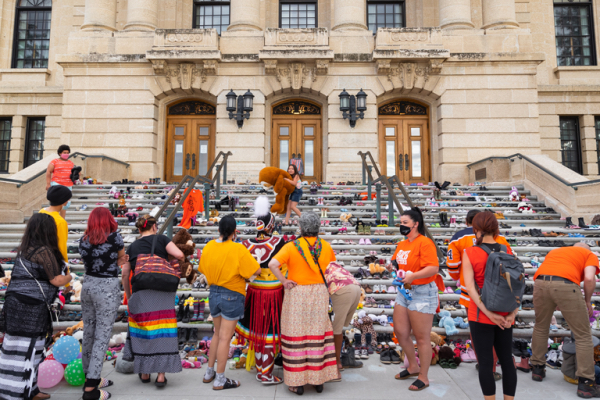
Creating a path towards ReconciliAction
By Aymen Sherwani, October 18 2022—
On Sept. 29, Elder Kerrie Moore — hosted by the Faculty of Social Work — spoke at the University of Calgary prior to the National Day for Truth and Reconciliation about what healing looks like. In doing so, she introduces how the notion of “Reconciliation” can be turned into “ReconciliAction,” further detailing the importance of acknowledging the existence of grief and trauma in a path towards creating safe spaces that are inclusive of Indigenous histories.
“When we talk about what has happened to Indigenous people, we recognize that the trauma that happened and has been passed down to all of our children, grandchildren now and our great grandchildren,” said Moore, who is a Metis/Cree Elder of the Metis Nation of Alberta and also a psychotherapist and sessional instructor, specializing in intergenerational trauma. “What we have to recognize is that we have to get Indigenous people back to the way we were — before colonization happened — a lot of us found that way back […] a lot of our children are being raised in that way of our ancestors within our culture.”
Moore’s extensive line of work has ranged all the way from facilitating healing circles for women involved with the justice system to creating other more culturally appropriate services for Indigenous people in Calgary. During this event, she introduces her Theory of Change — the culturally integrative mechanism by which she supports others in their path towards healing, whether it be in regards to children’s education, justice or mental health.
“The Theory of Change is the protocol of how we, as Indigenous people, work in our lives […] when we think about healing at this point, we have to offer programs and practices where they’re seeing and learning about themselves, not about you,” she said. “It’s about ‘where are the elders?,’ ‘where are the knowledge keepers?’ and ‘where are the people that have the knowledge that they can teach us, again?’”
At the same time, as Moore explains, a huge part of ReconciliAction is not only making programs more culturally integrative of Indigenous ways of knowing, but also ensuring that Indigenous people themselves feel safe and comfortable in such spaces — particularly in the context of whether one is experiencing the impacts of intergenerational trauma.
“Creating safety is the most important thing you will ever do — you can’t move forward in your programs, if the people in your programs aren’t safe,” she said, in the context of individuals who struggle with carrying trauma on a day to day basis, going on to highlight the importance of a cultural connection as a key element for healing. “As practitioners — as elders — we see kids who are relaxed, they start to talk, they start to experience that connection, they now feel a sense of belonging — that sense of belonging is what creates that safety, so that’s when you can start that healing.”
What this looks like for students is exactly this — take the time to register for events like this. As Truth and Reconciliation Day has recently passed us, take the time to learn from Indigenous scholars and active members of the community themselves about what the truth is and about what ReconciliAction looks like. Visit the Office of Indigenous Engagement’s page for more information.
This article is a part of our Voices section does not necessarily reflect the views of the Gauntlet editorial board.
